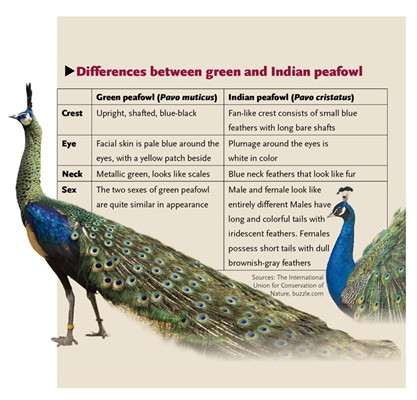
○ The green peafowl, long seen as the real-life phoenix, is disappearing from China
○ A wild rush to build dams in Southwest China's Yunnan Province has been blamed for the destruction of their habitat
○ Environmental NGOs are calling on the authorities to stop a large hydroelectric project that may destroy the last home of the bird in China
Three Beijing-based environmental NGOs are calling for work on a hydropower station in Southwest China's Yunnan Province to be suspended in order to protect China's last remaining green peafowl habitat.
Wild China Film, Friends of Nature and the Shan Shui Conservation Center have recently sent the central authorities and the local government a joint letter expressing their concerns over the national first-class protected bird, describing the damage the station will likely inflict on its habitat and proposing that work be stopped.
"The Ministry of Environmental Protection (MEP) confirmed that they received the letter and are preparing an official response," Zhang Boju, secretary-general of Friends of Nature, told the Global Times on Monday.
"We found that they may have failed to assess the station's possible impact on biodiversity, even though there are many national protected animals and plants there," he noted.
Decline
The green peafowl (Pavo muticus), a peafowl species now mainly found in the tropical forests of Southeast Asia, was once widespread in China. It appeared in artworks and literature for centuries, as the bird was regarded as the embodiment of the mythical phoenix and as highly auspicious.
But now most peafowl on display in China are not the native green bird, but are instead blue Indian peafowl, a species native to that subcontinent. "No Chinese zoo has a pure green peafowl," Chinese Science News said in a recent report, quoting an employee of the Chinese Association of Zoological Gardens.
In the 1990s, there were an estimated 1,000 green peafowl in China. But according to a survey of 34 counties and cities which have historical records of the species conducted by the Kunming Institute of Zoology in 2013 and 2014, green peafowl were only spotted in 11 of the areas, and the bird's total population was then likely no more than 500 individuals.
"Two decades ago, I was determined to let outsiders know that there were also Yunnan snub-nosed monkeys besides elephants and peafowl. But now, I found that the green peafowl are almost gone, and there are much fewer of them than there are monkeys," lamented Xi Zhinong, a well-known wildlife photographer and conservationist, while giving a talk about his conservation experience at a Beijing coffee shop on April 20.
In 1990s, largely thanks to Xi's efforts, large-scale deforestation was stopped in Yunnan and the habitat of the endangered monkey, which is unique to China, has been protected. In 2001, he established Wild China Film to promote conservation through wildlife photography.
Due to a rapid decline in population numbers owing to intense habitat destruction and high hunting levels, the Switzerland-based International Union for Conservation of Nature (IUCN), which calls itself "the world's largest and most diverse environmental network," changed the green peafowl's status from "Vulnerable" to "Endangered" in 2009.
According to the IUCN, there are about 15,000-30,000 green peafowl in the world, mainly in Cambodia, Myanmar and Vietnam.
Dam-building and deforestation have been mainly blamed for the bird's near-disappearance in China.
"Forests and flat riversides are vital to the green peafowl's survival. Tropical forests along rivers provide ample food and cover, while the males display their tail feathers and attract a mate in the open spaces of riversides," said Chen Wanrong from Wild China Film.
She believes that dams and the industrial development that accompanies them will ruin one of China's last unspoiled tropical forests, home to many tropical plants and animals.
Dam damage
China's green peafowl are mainly found between Shuangbai county, the Chuxiong Yi Autonomous Prefecture, and Xinping Yi and Dai Autonomous County, Yuxi, in the upper reaches of the Red River in Yunnan.
In March, Xi led an investigation tour to the region and discovered a small hydropower station, the Jiasajiang Level 1 Power Station, is being built there, with the valley floor now bare of trees.
"Once the station enters into service, the largest remaining habitat for green peafowl will be totally destroyed, and the species will likely go extinct [in China] in the short term. The impact will be irreversible and fatal," the three organizations warned in the proposal they sent to the MEP on March 30.


















































